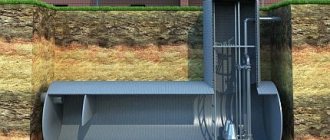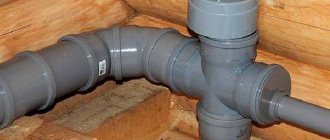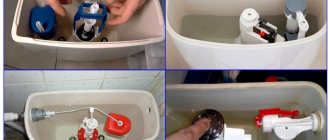Careful attitude towards plumbing in general and sewer lines in particular is the key to its long and reliable operation. It is no secret that fat deposits are the main cause of blockages in any such system. In the West, a household grease trap under the sink is installed in almost every home; for our vast homeland this is still a new product. In this article I will talk in detail about what this “beast” is, why it is needed, how to select and install it. I will also tell you about my own experience of creating a grease trap with my own hands.
You can buy high-quality grease traps here!
What is a grease trap?
Blockages in sewer systems are a very common problem in country houses with independent sewerage. A common reason for this is improper pipe laying during installation, the discharge of substances that cannot be dissolved, as well as wastewater with too much greasy particles. The last cause of the problem can be solved by installing a grease trap under the sink.
This is a special device that prevents grease from entering sewers and treatment facilities.
It has long been used almost everywhere in restaurants, cafes, bars, small bakeries, pubs, confectionery shops, as well as in industrial enterprises where poultry and meat are processed. But recently it has begun to spread for household needs.
Such small devices are designed for cleaning small amounts of grease and household waste. They are installed under the sink and are able to work with different productivity, different volumes, or as it is called maximum (peak) discharge.
The workshop device can be replaced with several small devices installed under the sinks. Thanks to this, the volume of fat entering the sewer system is reduced.
The equipment consists of a housing with inlet and outlet pipes. Inside there is a partition of one compartment, a flow damper and a hole that removes air. A ventilation tube is installed above the surface where fatty waste accumulates.
Currently, there are many types of devices. They are classified depending on the material of manufacture and the method of installation and cleaning.
Homemade grease trap
In the simplest version, you can make a household grease trap for washing yourself. To be honest, for small city apartments it is not particularly needed, although this is just my opinion. But in a private house or a good dacha with a local sewer system, this device will significantly protect the drainage system from blockages.
Drawing of a sewer separator for a private house.
The second big advantage that such an installation gives in a private home is the protection of the septic tank for cleaning wastewater. After all, the main filtering force in most of these septic tanks is bacteria, and the less fat there is in the septic tank, the better such bacteria will develop.
When I set out to build such a filter, two main questions immediately arose:
- Firstly, what volume should the tank have;
- And secondly, where to get a suitable tank for a homemade separator.
How to calculate capacity
In industrial models, such calculations are based on rather complex formulas, which take into account a lot of various side components. In the everyday version, you don’t need to take all this into account; here you can get by with a couple of simple calculations.
Square plastic grease trap.
The first thing we need to know is the performance of the grease trap, it is calculated using the formula:
P = n*Ps
Where P is the required performance;
n – number of kitchen sinks in the house;
Ps is the speed at which water flows into your water supply. Usually it is 0.1 l/s.
I have only one sink in my kitchen, and there is also a second unknown one. As a result, having substituted the data, I received a productivity equal to 0.1 l/s (P=1*0.1).
The process of cleaning the device.
To calculate the volume of the tank there is another formula:
V = 60*P*t
Where “t” is the time of separation of fat from water (in our case, fat floating to the surface), according to the tabular data, this time is about 6 minutes. And now we can get the final result (V=60*0.1*6=36 liters).
Using simple calculations, I calculated the approximate dimensions of the tank itself. In order for the container to hold about 36 liters, it is necessary to build a box with dimensions 400x300x300 mm (length/width/height).
How to make a grease trap
Naturally, the dimensions that I received are just a starting point, a minimum. The larger we make the tank, the greater the safety margin we will get.
Possible parameters of a household grease trap.
The easiest way is to find a ready-made box and install a simple filling of several partitions in it. But for me, the search for a normal plastic box was unsuccessful.
The fact is that the containers that I saw in the store had a round neck, and I wanted some kind of chest. Moreover, this “chest” should be closed hermetically. This is not a whim, it’s just a grease trap, the lid of which opens over the entire area, which will be much easier to clean later.
After rummaging around in my “homeland’s bins,” I found an old aquarium with cracked glass. The thing is basically useless, but the frame made of duralumin corner could be used.
Separator with one fat-collecting sector.
Then there were only technical aspects. First, I pulled out all the glass from the old aquarium, after which I carefully cleaned the aluminum frame inside and out.
I used a 6 mm thick fiberglass sheet as the walls and lid for the box. Of course, it is difficult to cut, but it has exceptional strength, is also not afraid of moisture and is indifferent to most chemical reagents.
Homemade grease trap from a round tank.
There are now a lot of different adhesives on the market for gluing fiberglass, so there were no problems with choosing the composition. To be on the safe side, after the box was glued and all the necessary partitions were inserted inside the homemade sewer separator, I coated all the joints with sealant.
I also didn’t think twice about the airtight lid. I glued a rubber seal on top of the duralumin corner. Then I attached ordinary hooks to the bolts at 4 points, and screwed hooks under these hooks on the fiberglass cover. Sorry, I don’t remember what these hooks are called correctly, but they are usually placed on the lids of chests and boxes.
Metal hooks for fixing the lid.
In order to cut even holes for plastic pipes with a cross-section of 50 mm, I used a round bit of the appropriate size, it turned out clearly and beautifully. I glued the joints between the walls and the plastic pipes and coated them with sealants.
I made the connections from the sink to the grease trap and from the grease trap to the sewer drain from corrugated plastic pipes, plus I used rubber seals.
Siphon made of corrugated pipe.
There is not much space under the sink, and if you install a grease trap, then, as a rule, a standard siphon will no longer fit. In this case, you can install a curved pipe, although I made it even simpler. I used a plastic clamp to tighten the corrugated pipe so that I got a curved water seal. It doesn't look very good, of course, but it's been working fine for a couple of years now.
Connecting the device using corrugated pipes.
Principle of operation
Wastewater with fat flows into the treatment system, where at the initial stage the suspended particles precipitate, and the fats remain as a film on the surface. The water is then sent to the second stage of purification, where it is separated from the fat. The partition prevents these particles from entering the second compartment. The purified water then goes into the sewer system.
In cafes and canteens, sinks come in cumulative and flow-through types. With the storage type, the dishes are washed in a sink filled with water, after which the plug is removed and the water flows into the drain. A household grease trap under the sink, in this case, is installed based on the volume of the volley discharge being equal to the volume of the sink. For flow-through washers, the calculation is 0.5 m3/h.
Operating principle
Purifying wastewater from grease is not that complicated and is based on the difference in the physical properties of water and grease. Fats, animal and vegetable, are always lighter in specific gravity than water, have a lower density, and, therefore, collect on the surface of the water as a heavier liquid. The substance collected at the top can be removed using special chambers through which the purified waste flows sequentially.
The sewer separator works as follows:
- A container with chambers (sectors) and a tight-fitting lid is installed under the sink. Dirty water flows into the first chamber of the tank from the sink drain (primary treatment sector), and water flows out from the last sector, already cleared of grease;
- Inside the container, the chambers are separated by partitions;
- Between the sectors, the wall does not reach the bottom of the container, leaving a gap for water to flow;
- From the second chamber (secondary treatment sector), water also flows through a gap near the bottom into the third chamber. In principle, you can do without a second chamber, but it is installed for additional wastewater treatment and allows you to almost completely free the drains from fats;
- To remove solid waste, a third partition is installed behind the second partition, not reaching a few centimeters from the water surface.
- After this, completely purified water flows into the sewer.
When the first chamber is filled with retained fat, the device is removed, cleaned, and then reconnected to the pipes from the sink and drain. Household grease traps can be easily cleaned yourself, while industrial ones are cleaned with special pumps.
Installing such a separator ensures that there are no blockages in the home sewer system. Anyone who knows how to use simple tools can install it into the system. You can clean your household appliance rarely - no more than once every two weeks. Only a small amount of fatty waste will enter the sewer, which is not enough to deposit deposits on the walls of the pipes and cause blockages.
Types of manufacturing materials
In particular, grease traps for sinks are made from various materials. This:
- stainless steel,
- fiberglass,
- plastic.
The most economical of all types of devices are plastic devices. Therefore, buyers choose this type most of all.
Grease traps for sinks made of fiberglass are mainly purchased for industrial enterprises. Such devices are installed outdoors, since the material is highly resistant to weather changes, as well as to chemical reagents.
The most expensive are, of course, stainless steel appliances. Only the most profitable industrial enterprises afford such grease traps for sinks. But, at the same time, their hygienic properties and service life are the highest.
How to choose a device for your home
The initial stage of choosing a grease trap is carried out not in a hardware store or on the Internet, but in the planned location of its installation. Before purchasing a device, you need to decide on a number of parameters that will help you narrow down your options to a few models.
First of all, it is worth assessing:
- Dimensions of free space under the sink . It should be taken into account that there should be space at the top for removing the cover, and at the sides for connecting pipes.
- Diameter of sewer pipes in the kitchen . It is better to buy a grease trap with the same hole size so as not to use additional plastic adapters.
- Number of sinks served . When calculating productivity, it is necessary to take into account the simultaneous flow of wastewater from all open taps.
- Characteristics of effluents . If there is a large amount of solid particles in the drained water, it is recommended to install grease trap models with several partitions.
- The presence of a sewer riser or drain pipe near the sink - the channel is necessary to prevent the failure of the water seal on the siphon. Models with an air duct are preferable, but the possibility of connecting them to a sewer riser is not available in every apartment or house.
- Availability of free space for equipment maintenance work. When removing grease, unpleasant-smelling waste may end up behind the grease trap body, so it must be possible to clean this space
- Case material . For installation under the sink, a regular plastic grease trap will be sufficient, but if it is open for viewing, you can buy a more expensive and aesthetic model made of stainless steel.
- Washing volume . Sometimes you need to dump water from a fully filled sink in one gulp. This amount of liquid is one of the characteristics of the grease trap and must be indicated in the instructions.
After taking into account all the nuances described above, you can begin to directly select a suitable device from the options offered on the market.
The price of a budget plastic grease trap approximately corresponds to the cost of a sink along with furniture, faucet and siphon, so you need to plan its purchase in advance (+)
The price of plastic models depends mainly on the volume of the tank and the complexity of the internal structure. Given the same parameters, it is better to choose the cheaper option, because a more expensive model is unlikely to be of better quality.
Types depending on installation
Devices can be installed in different ways. Based on this property, they can be divided into the following types of devices:
- mounted under the sink,
- installed in another room,
- installed in the basement,
- installed outdoors.
The first three types have no fundamental differences, except that the distance from the place where washing is performed is different.
On the street, mainly devices used for industrial enterprises are installed. They can be made of stainless steel or fiberglass, but not of plastic, since such a coating can be damaged due to weather conditions and interaction with an aggressive environment, namely chemical reagents.
Grease separators from the manufacturer with a quality guarantee
offers a wide range of grease separators designed for sewer systems. All main elements of equipment are made on the basis of high-quality reinforced fiberglass. Thanks to this, it is possible to extend the service life of devices to 25-50 years. The devices presented in the company’s catalog not only have high efficiency, practicality and durability, but also have an aesthetic appearance.
The products are offered at an affordable price in two versions: horizontal and vertical. If you find it difficult to choose a particular type of equipment, the company’s experienced managers are ready to provide comprehensive advice on all issues of interest. You will be able to quickly select and purchase the most suitable device in terms of price and performance on favorable terms.
Please note that, if desired, customers can also order the installation of a level switch LC2-1. This is a device that allows you to control the level of fat or oil accumulated in equipment containers. When the sump tank is full, a light or sound signal will be issued. This prevents the grease trap from becoming less efficient due to excessive accumulation of grease or oil in the container.
Types by cleaning method
Devices are differentiated depending on how cleaning is carried out. So they are divided into:
- Devices that are cleaned manually . These are the most popular household devices. When cleaning, use cleaning products available on hand. They do not have high throughput.
- Another type of device differs in that special pumps are used for cleaning . The automated functions of the devices are capable of informing themselves that preventive maintenance should be carried out.
It is clear that this type is in demand only in industrial enterprises. They often have outdoor installation.
Operating Parameters
When evaluating grease traps, don't just focus on the body material - it's equally important to pay attention to performance characteristics such as capacity, peak discharge and cleaning method. Let's study each parameter in more detail.
You can install the grease trap yourself
Performance. This indicator determines how much water the device passes through in a certain period of time. It is logical that the higher the productivity, the more efficiently the grease trap works, but in the case of a household model, you should not chase high numbers - you will simply overpay. As practice shows, for domestic needs the simplest model with a standard capacity of 0.5 l/s is quite sufficient.
Advice. On sale you can find grease traps with a performance level of 0.1-0.2 l/s, but even if you do not often use the kitchen sink, it is better to avoid such models - they are not much cheaper than standard ones, but they are noticeably inferior in operating speed.
Peak discharge . Determines the volume of used water that the grease trap passes at one time. The discharge of household appliances varies between 25-175 liters - the higher this figure, the more powerful the device.
Cleaning method . There are two types of grease traps: with manual and automatic cleaning. The user will have to service the first models independently using any detergents designed to combat grease. And in the second devices there is a special sensor that reacts to the level of fat, and a small pump: when the sensor shows that the chambers are too dirty, the pump services them automatically.
Cleaning the Grease Trap
For good equipment operation, it is important not only to install it, but also to properly maintain it. This way, the grease trap under the sink will last much longer.
It is necessary to clean the device depending on the volume of water passing through the kitchen, the capacity of the device, the type of sink itself, and peak discharge. If, for example, it is known that a smaller salvo discharge is used than necessary, then cleaning should be carried out at least once every two to three days with frequent use, or once or twice a month with rare use. In other cases, equipment must be cleaned less frequently, approximately once every six months.
To clean the grease trap under the sink, you need to remove its lid and first put on rubber gloves to remove all the grease and sediment inside. Of course, doing this is completely unpleasant, but it is necessary.
In addition to mechanical cleaning, the so-called neutralization of fats can be used, when special biological products or microorganisms can make a liquid mass from fat deposits on the walls of the device. In this case, it is necessary to choose biological products that can easily tolerate solutions of chemical cleaning agents, hot water, and also destroy bacteria.
When using the product, it is extremely important to store it very carefully so that nothing leaks through the body of the device, because such preparations containing unicellular and multicellular microorganisms are harmful to human health.
Separator maintenance and monitoring
Servicing a grease trap is not the most pleasant procedure, but it is much more unpleasant to clean out clogged sewer pipes.
The frequency of cleaning a household separator depends on several parameters:
- volume of the grease trap tank;
- family diet, which determines the composition of wastewater;
- temperature of the water used.
Due to these factors, the frequency of separator cleaning may vary from several weeks to several months.
Before cleaning the grease trap, it is necessary to open the windows for cross ventilation and wear protective gloves, because harmful bacteria multiply during the breakdown of fats
Close attention to the level of wastewater must be paid in the first weeks of operation. It is necessary to periodically open the grease trap lid and check the level of solid waste. If the bottom layer of fat reaches the level of the outlet, it may become clogged, causing the tank to overflow and flood the room.
It is advisable to remove the fat mass when it reaches a level 4-5 cm above the lower edge of the water drainage pipe. To remove fat, you need to open the tank lid and pull out the top viscous layer using gloves, a ladle or other available device.
After inspecting the grease trap, you can rinse it with hot water for several minutes.
When the approximate period of safe operation of a grease trap has already been established experimentally, you can look into it much less often.
More details about the different types of grease traps for sewage, an overview of popular models, as well as the specifics of installing the separator indoors and outdoors are described in this article.
Installing the device yourself
Before installing a grease trap under the sink, you need to accurately check the space where it will be located in the future. In order to have unhindered access to the device (for its regular maintenance during operation), it is advisable to leave up to two to three centimeters of space between it and the furniture cabinet where it will be placed.
The surface where the device will be mounted must be perfectly flat without a single flaw, since otherwise the efficiency of its operation will be reduced and the fatty layer of waste may pour out of the sump.
When installing a grease trap under a sink, you must comply with all fire safety rules that prohibit its installation and operation near flammable appliances.
Any device has accompanying instructions, which provide information about the operation of the device and its installation. Following simple recommendations, it is easy to install it yourself. Special fasteners, fittings and everything else are basically contained in the kit. However, it happens that they need to be purchased additionally.
After installation, the device is turned on for the first test. Its purpose is to find out whether there are potential leaks somewhere. Most often, insufficiently reliable joints are found in places where the device is connected to the sewer system. Therefore, in such places it would be useful to use silicone lubricant and sealing tapes, which increase the effectiveness of sealing at the joints.
We recommend Dimensions of reinforced concrete rings for a well according to GOST. What types of rings are there? How to install correctly
Device Features
The purpose of this type of equipment is to prepare wastewater for discharge into the public sewer network, which, according to legislation, is associated with strict standards regarding the mass fraction of fats allowed in wastewater.
The grease trap container is located along the path of wastewater in the sanitary sewer from public catering establishments (restaurants, canteens, cafes, cheburek shops), food production facilities and private homes.
Underground structure
The reservoir performs the following functions:
- separates, collects and removes oil and grease from wastewater;
- protects treatment tanks, private and public sewers from the formation of grease plugs;
- prevents blocking of highways in certain areas, which can lead to a serious accident. By settling on the inner walls of pipes, fat eventually reduces their diameter and permeability, causing blockages;
- ensures compliance with current standards for the content of harmful impurities in the form of fat in wastewater;
- increases the cost-effectiveness of sewer system maintenance.
Plastic compact version
Recently, quite stringent requirements have been imposed on the state of wastewater regarding the fat content in it at the legislative level. To ensure compliance with them and avoid penalties from inspection authorities, grease traps are equipped with a sorption filter. This allows you to obtain an output amount of fatty products of no more than 1 mg/l.
Sorption filter for wastewater
In addition to this, underground devices, regardless of type and modification, are equipped with the following:
- a meter with a sound block to control fat levels;
- a device for monitoring the level of sediment;
- device for signaling the filling of the tank;
- automated system for collecting and removing fat;
- automated sludge removal system.
To operate equipment in regions with a predominance of low temperatures and shallow reservoirs, the body of the grease traps is insulated.
Operating principle of the device











